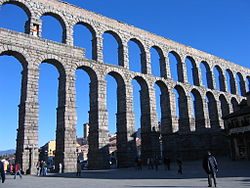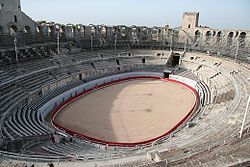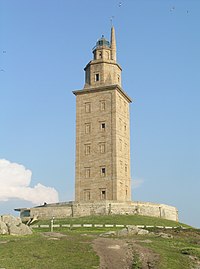

The Roman use of the arch and their improvements in the use of concrete and bricks facilitated the building of the many aqueducts throughout the empire, such as the magnificent Aqueduct of Segovia and the eleven aqueducts in Rome itself, such as Aqua Claudia and Anio Novus. The same idea produced numerous bridges, such as the still used bridge at Merida.
The dome permitted construction of vaulted ceilings and provided large covered public space such as the public baths and basilicas. The Romans based much of their architecture on the dome, such as Hadrian's Pantheon in the city of Rome, the Baths of Diocletian and the Baths of Caracalla.

Art historians such as Gottfried Richter in the 20's identified the Roman architectural innovation as being the Triumphal Arch and it is poignant to see how this symbol of power on earth was transformed and utilised within the Christian basilicas when the Roman Empire of the West was on its last legs: The arch was set before the altar to symbolize the triumph of Christ and the after life. It is in their impressive aqueducts that we see the arch triumphant, especially in the many surviving examples, such as the Pont du Gard, the aqueduct at Segovia and the remains of the Aqueducts of Rome itself. Their survival is testimony to the durability of their materials and design.
Housing

Although less visible level to the modern observer, ancient Roman developments in housing and public hygiene are impressive, especially given their day and age. Clear examples are public and private baths and latrines, and under-floor heating in the form of the hypocaust, double glazing (examples in Ostia Antica), and piped water(examples in Pompeii).
Possibly most impressive from an urban planning point of view are the multi-story apartment blocks called insulae that catered to a wide range of residential situations. These buildings, solely intended for large scale accommodation, could reach several floors in height. Insulates were often dangerous, unhealthy, and prone to fires. There are examples in cities like the Roman port town of Ostia, that date back to the reign of Trajan and show how Roman architects met residential needs in a variety of situations.
As an example, consider the housing on Via della Focette: a large-scale real estate development that catered to up-and-coming middle class entrepreneurs. Rather like modern semi-detached housing, these residences had repeated floor plans intended for easy, economical, and repetitive construction. Internal spaces were designed to be relatively low-cost, yet functional and with decorative elements reminiscent of the detached houses and villas to which the buyers might aspire later in their lives. Each apartment had its own terrace and private entrance. External walls were in "Opus Reticulatum" and interiors in "Opus Incertum", which would then be plastered and sometimes painted. Some existing examples show that a relatively popular choice of interior decor was to paint panels in alternating red and rainbow.
Public buildings

Roman architecture was sometimes determined based upon the requirements of Roman religion. For example, the Pantheon was an amazing engineering feat created for religious purposes, and its design (the large dome and open spaces) was made to fit the requirements of the religious services. Some of the most impressive public buildings are the amphitheatres, over 220 being known and many of which are well preserved, such as that at Arles, as well as the progenitor, the Colosseum in Rome. They were used for gladiatorial contests, public displays, public meetings and bullfights, the last of which survives in Spain. They are among the most impressive remains of the Roman empire at its height, and many of them are still used for public displays and performances.
Lighthouses

Many lighthouses were built around the Mediterranean and around the shores of their expanding empire, including the Tower of Hercules at A Coruña in northern Spain, a structure which still survives to this day. A smaller lighthouse at Dover, England also still exists as a ruin about half the height of the original. The light would have been provided by a fire at the top of the structure.

No comments:
Post a Comment